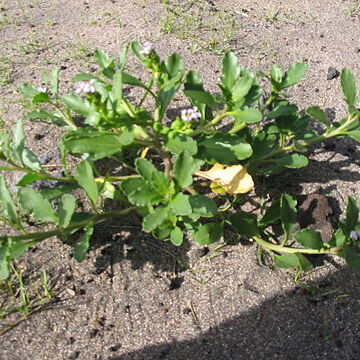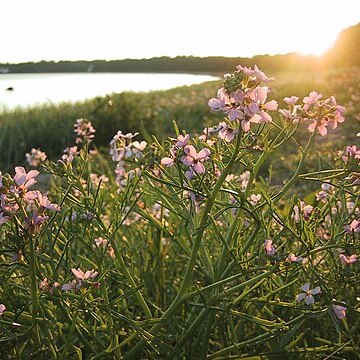Pet obovate, pink or purplish to white; short stamens subtended by a minute gland, long stamens separated by a larger gland; anthers ovate-oblong; ovary cylindric, with imperfect septum; ovules 2–4; style not differentiated; stigma truncate; fr indehiscent, corky when dry, transversely divided into 2 dissimilar joints, the lower persistent, 1-seeded or seedless, the upper eventually deciduous, fertile, usually 1-seeded, ovoid or lance-ovoid, 2-or 4-angled or ± 8-angled (2 sutures, and 3 nerves for each valve); seed suspended in the lower joint, erect in the upper; coarse, succulent annuals of coastal sands, much-branched, with spreading or ascending stems and oblanceolate to obovate, dentate to pinnatifid lvs. 7, widespread.
Annual taprooted herbs. Glabrous. Stems ascending, leafy. Lvs not lobed to pinnatifid; margin entire, crenate or bluntly toothed. Racemes ebracteate. Sepals erect, the inner saccate. Petals white to pink to purple. Stamens 6, without appendages. Lateral nectaries 2, crescent-shaped behind single stamens; median 2, variously shaped, in front of paired stamens. Style short; stigma capitate. Silique indehiscent, dry and corky, composed of 2 falsely 1-celled, jointed, indehiscent segments: upper segment beaked, terete or angled, detaching at joint; lower segment narrower, cylindric, or obconic, sometimes weakly angled, stalk-like when seedless. Seeds ellipsoid, not winged, (0)-1 per segment.
Annual (rarely perennial) succulent herbs, glaucous, glabrous. Sepals erect, the laterals saccate. Petals long-clawed. Stamens 6. Nectariferous glands 4, crescent-shaped glands inside base of short stamens; variously shaped glands outside base of long stamens. Silicula indehiscent, corky, aseptate, differentiated into two segments; upper segment conical to flattened, l-seeded; lower segment various, usually 1-seeded. Seeds dimorphic, erect in upper segment, pendulous in lower; radicle accumbent.
Annual or biennial herbs, succulent; stems intricately branched, fairly stout, decumbent; leaves fleshy when fresh, entire to nearly pinnate, petioled or sessile, never-clasping; inflorescence racemose, ebracteate; flowers white to purplish, petals not conspicuous; infructescence elongated; pedicels thick; siliques indehiscent, composed of two joints which disarticulate freely at maturity; lower joint turbi-nate, 1-seeded, upper joint gradually tapering to a beak; seeds oblong, wingless.


